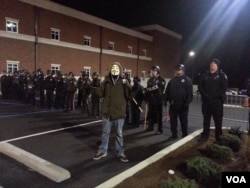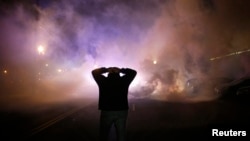Michael Brown, an African-American teenager, was shot by police officer Darren Wilson, who is white, six times on August 9, setting off weeks of unrest in the St. Louis suburb.
That Wilson shot Brown is about the only thing that has been certain about the case.
Brown was unarmed when Wilson shot him. The officer reportedly stopped the teen and a friend as they were walking in the middle of a street. Witnesses said Brown had his arms raised in surrender and was shot multiple times even though he had run from Wilson.
A review of the 18-year-old's official autopsy report, however, found Brown may have been reaching for the officer's weapon as police officials have reported. It indicates Brown's wounds were consistent with Wilson's reported claim that he and Brown struggled inside his police car.
Wilson married in October
Meanwhile, St. Louis County records released Monday indicate that Wilson got married last month, The New York Times first reported. He married another Ferguson Police Department officer, Barbara Spradling, on Oct. 24. He has been on paid leave since the shooting.
The news drew a bitter response from Deray McKesson, a local activist. The Chicago Tribune reported that McKesson tweeted: “Darren Wilson is out here CHILLIN. His life clearly hasn’t slowed down even though Mike’s ended.”
Racial divide
The incident exposed deep racial tensions in the small town, leading to violent clashes between police and residents.
One key element in fueling those tensions in Ferguson was that the community of about 21,000 had slowly morphed from a majority white town into a majority black town -- without the demographic shift being reflected among the town’s leadership and police force.
"In 1980, 80 percent of the population in Ferguson was white. In 2010, the population was 85 percent black. So you can see the dramatic changing," said Sam Fulwood III, a senior fellow at the Center for American Progress, told VOA in August. “As Ferguson became ever more populated by communities of color, it also became poorer.”
Voter turnout in local Ferguson elections does not even reach double digits, pointing to signs of a large segment of the population being marginalized
The shooting also spurred a national debate on police practices toward African-Americans.
According to a Pew Research Center poll done in August, 80 percent of black adults surveyed believed the case raised important issues about race. Only one third of white respondents agreed.
Police violence
The civil rights group NAACP has asked the U.S. Justice Department for “wholesale policy changes” to address police violence against black Americans.
The week after Brown’s death, the organization's Legal Defense Fund wrote a five-page letter to U.S. Attorney General Eric Holder, detailing 13 cases of what it called the “unjustified use of lethal and excessive force by police."
Among the NAACP's demands: more racial, ethnic and gender diversity in law enforcement, and more police officers who are members of the community they serve. U.S. Attorney General Eric Holder has ordered an investigation into whether the Ferguson police department was involved in racial profiling and how the force handled the protests.
'Militarization' trend
The case also triggered a national debate on the “militarization” of local police forces around the country in recent decades. In the 1990s, when crime in the U.S. was much more prevalent, a law was passed that allowed local and state police department to acquire surplus military equipment as well as tactical training from the Pentagon.
St. Louis County, where Ferguson is, received 12 5.56-mm rifles, six .45 caliber pistols, multiple cargo trailers and other vehicles, as well as night vision equipment through the program.
Critics say the militarization of the police causes the police department to employ heavy-handed law enforcement tactics.
The Federal Bureau of Investigation said the grand jury announcement "will likely be exploited by some individuals to justify threats and attacks against law enforcement and critical infrastructure," in a warning issued earlier this month.
President weighs in
President Barack Obama, speaking Sunday on ABC News’ “This Week,” said he had called Missouri’s governor, Jay Nixon, “to make sure that he has a plan to respond in a careful and appropriate way to any potential violence – to be able to sort out the vast majority of peaceful protesters from the handful who are not.”
Obama said he hoped for better training of law enforcement personnel “to be sensitive to the concerns of minority communities” so “over time trust can be built, in part because minority communities typically are subject to more crime. They need law enforcement more than anybody. …
“There are a lot of communities – in my hometown of Chicago, for example – [that] want to actually see more police,” the president continued. But “they want to make sure the police are trained, so they can distinguish between a gangbanger and a kid who just happens to be wearing a hoodie but just otherwise is a good kid and not doing anything wrong.”
Ferguson grand jury
Susan McGraugh, a professor of criminal defense at St. Louis University Law School, said the Ferguson grand jury differs in some ways from the textbook definition.
In typical proceedings, McGraugh said, prosecutors know “what charge they would like the grand jury to hear. They’ll give the grand jury information and evidence just about that charge and about that defendant, and then ask them to vote in favor of that charge.”
In this case, “the grand jury is being used in a more investigative role,” she said. Jurors “will hear all the evidence regarding the case – not just the evidence that’s good for the state or the prosecutor.” Then they’ll have to decide whether to charge Wilson with a crime and, if so, will have to “choose among several different charges."
The law professor said forensic evidence in this case “seems to be playing a particularly prominent role, because there has been a private pathologist hired to do a second autopsy on Michael Brown and some of his findings have been different from the findings of the forensic pathologist” hired by St. Louis County.
The overall situation in Ferguson could be improved, McGraugh said.
“The first thing that needs to happen is dialogue,” the professor said. “I think people have to acknowledge that there is a problem and most people were unwilling to do that until the Michael Brown shooting brought so many of these facts to light. ... For people in communities of color to feel that their concerns have been heard and acknowledged has got to be the first step."

















